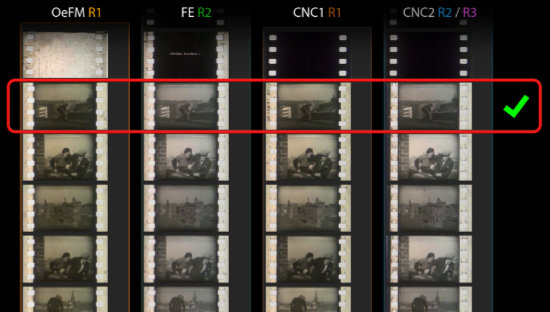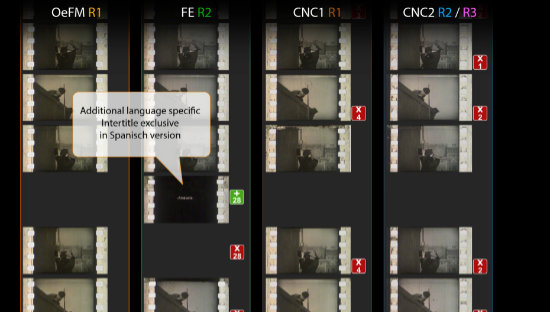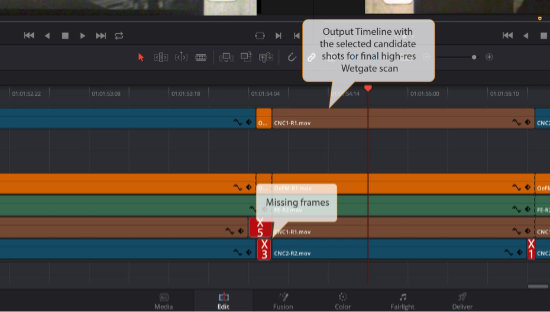The Chase After Millions
An advanced restoration project as proof-of-concept for a new film inspection tool
DFF - Deutsches Filminstitut & Filmmuseum in Frankfurt am Main, Germany, has a film archive department in Wiesbaden which preserves about 27,000 print and pre-print elements. This film archive collection houses a wide range of films, ranging from early cinema through the German avantgarde of the 1920s and 1930s to the great works of Weimar cinema and “New German Cinema”, as well as European auteur cinema and art-house classics. As part of its core archival task, the DFF regularly undertakes restorations and reconstructions, both analogue and digital. Past projects have included HAMLET (D 1920/21) starring Asta Nielsen, the detective thriller DIE HOCHBAHNKATASTROPHE (The Elevated Train Disaster, D 1921) by Valy Arnheim, and DER KAMPF UMS MATTERHORN (D 1928) with Luis Trenker. Usually several months or even years of painstaking “pre-production” work, including complex philological research and a worldwide search for the best available film elements, goes into such projects, before select elements are digitized, restorative interventions are carried out, and the finished result can be presented on the big screen.

As anyone involved in film restoration will know only too well, no two elements of a single film are identical. Surviving elements must therefore be very carefully examined and compared in order to reach a final decision about which to use as source for duplication, whether by analogue or digital means. The decision-making process takes into account a number of different factors such as authenticity and completeness, photographic properties, as well as physical condition. The more elements available, the more complex and laborious this process is. For a recent project, Anke Mebold, restorer and project manager at DFF, was on the lookout for suitable technology to aid the process of inspecting and comparing multiple film elements of the silent feature-length comedythriller DIE JAGD NACH DER MILLION (The Chase After Millions, 1930), directed by Max Obal and featuring popular Italian action hero Luciano Albertini (1882-1945) in his final starring role.
The DFF digital restoration project of DIE JAGD NACH DER MILLION was launched in 2018 as a joint venture with film preservation expert Oliver Hanley. It’s genesis goes back quite some years: it was initiated by Oliver Hanley during his time as archivist and curator at the Austrian Film Museum in Vienna from 2011 to 2016. Back then he laid the essential groundwork, carrying out extensive background research on the film, its production and distribution history as well as its survival status. He located four first-generation nitrate prints at three European film archives, all members of the International Federation of Film Archives (FIAF): a print of the French release version owned by the Conseil Géneral de la Charente and preserved at the Archives Françaises du Film du CNC in Bois d’Arcy, a second print of the French version at the CNC, a print of a German-language Czech release held at the Austrian Film Museum in Vienna, and a fragmentary print of the Spanish release version from the Filmoteca Española in Madrid, currently deposited at the Austrian Film Museum. The four prints were produced on stocks of different manufacture and origin (Kodak, Gevaert, Agfa and Zeiss Ikon). All are incomplete to varying degrees, they exhibit a wide range of different properties and damages, along with discrepancies in their editing
To reproduce the lost original German premiere version, as documented by non-film sources such as censorship records, while sourcing from discrepant foreign release prints, seemed possible though demanding.

In order to carry out this digital restoration, which has received government funding through the Federal Commissioner for Culture and Media, DFF has been working together with its frequent collaborator, the renowned film laboratory and digital service provider Haghefilm Digitaal in Amsterdam. Haghefilm Digitaal has recently joined forces with the German manufacturer MWANova, founding the joint company Haghefilm MWA GmbH. DFF was thus able to draw on the possibilities provided by the new generation of Spinner film inspection tables recently developed by MWA.
All four elements, fragile and damaged vintage prints, spanning 23 reels with a total length of around 7245m (or a running time of just under four and a half hours), were run through the Spinner inspection table on MWA’s premises in Berlin in the autumn of 2018. This table can be equipped with the V-Black dark-field diagnostic sensor that integrates the very latest research and development for measuring and analysing surface-level defects. The patent-pending sensor, developed by the engineers at 5micron in Berlin, produced approximately half a million individual proxy image files that depict the full width of the 35mm film strip. This way the full scope of information visible beyond the borders of the frame, such as edge codes, splices and perforation defects, could be documented, and included in the process of comparative assessment toward selecting the best source for each individual shot of the film (1163 shots in total, not including titles).

The footage finally determined as best available source for each shot would be subsequently scanned wetgate, in 2K+ resolution, at Haghefilm’s laboratory facilities in Amsterdam. Toward this aim all four vintage prints had to be aligned frame accurately. Working with the low-resolution proxy files produced by MWA Spinner inspection table, Oliver Hanley carried out the meticulous and timeconsuming task of aligning the preliminary duplicates of all four prints, frame-by-frame, in a nonlinear video editing programme (NLE).
The resulting manually-produced split-screen comparison video was used as a reference for proof-of-concept that the image compare and alignment task can be successfully automated. Cube-Tec’s new QUADRIGA•VersionCompare software is able to master such a complex and challenging task in a fully automated process. For this an innovative image sequence segmentation technology was developed which includes an image by image compare and a shot boundary detection. These combined techniques supports the automated frame accurate detection of editorial differences between these film versions and can support the selection process to fine tune the preservation and/or restoration strategy. And we are pleased to announce that QUADRIGA•VersionCompare has passed this test with flying colours.
QUADRIGA•VersionCompare goes even further and can synthesize the pick- & to-do list for the final high-res scanning job, and it can even generate scan project files for ARRISCAN automatically. Contact Cube-Tec to find out more.

